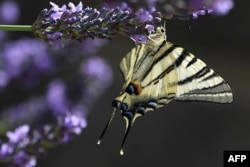Lack of food throughout the year is a leading cause of the world’s decreasing bee populations.
This is what they sound like when they are buzzing, or flying, around, looking for food.
During some seasons, there just is not enough nutrition in the natural environment to feed all of the bees.
Also decreasing are the diversity and numbers of flowering plant species. Reasons include use of pesticide products and development of what once were rural areas.
Bees, other insects and even some animals act as pollinators. They cause plants to make fruit or seeds. They do this by moving pollen, the yellow substance produced by plants, from one part of the flower of a plant to another.
However, pollen is the only protein that bees eat. They cannot survive without it. Bees also collect nectar from flowers when they bloom. They use it to build their energy while storing it in their stomachs. Later the nectar becomes honey.
How can you help the bees?
What do bees need?
“Plant flowering plants,” says Rebecca Finneran, a horticulture educator with Michigan State University Extension.
She adds, “People often only think of annual flowers as pollinator plants, but trees, shrubs, perennials, vines and herbs can provide a tasty diet for all types of pollinators.”
The overall pollinator collapse is worrisome because bees, wasps, flies and butterflies are an important part of growing more than a third of the food we eat.
How to help
Here are some ways you can help.
First, find out what time of year the food supply is low in your area, and decide which pollinators are affected. Next, see which plant species would help them.
You want biodiversity — a nice mix of different plants and animals. Different bees do different things, so it is a good idea to have wild bees as well as honeybees.
North America, for example, is home to over 4,000 species of wild bees. The color, shape and size of flowers each have different ways of appealing to pollinators, Finneran said.
It is important to have “a wide variety to ensure blooms will be available to pollinators throughout the season,” she said. “There is no ‘one size fits all,’ so I like to tell people to be thinking about mixing things up.”
When it comes to dealing with natural surroundings, less may be more. Let wild, unwanted plants bloom, she says. Use only the smallest amount of chemicals that can weaken or kill bees.
Once pollinator-friendly plants have bloomed, take off the dead flower so they can bloom again. Finneran suggests waiting to cut plants like hostas until they have fully finished blooming.
Pollinators need open ground and untouched areas, where some leave eggs or others raise their young. Do not work over the ground where they are, or clean that area in the fall.
Early spring can be when pollinators have the least amount of food, especially bees, Finneran said. The cold and windy weather makes longer flights difficult for some, she said.
“Later in fall, we see a decline in resources, especially for bumblebees,” Finneran said.
Beautiful flower garden designs may be satisfying, but pollinators do not care how your land looks, she added. Just offer them nutritious plants that bloom successively through the seasons.
I’m Anne Ball.
Dean Fosdick wrote this story for the Associated Press. Anne Ball adapted his report for VOA Learning English. George Grow was the editor. Bee sounds courtesy of reinsamba.
Do you have pollinators in your garden, if so, what kind? What do you think of this story? Write to us in the comments section below.
______________________________________________________________
Words in This Story
nectar – n. a sweet liquid produced by plants and used by bees in making honey
diversity – n. the quality or state of having many different forms, types or ideas
horticulture – n. the science of growing fruits, vegetables, and flowers
perennial – adj. of a plant : living for several years or for many years : having a life cycle that is more than two years long
vine – n. a plant that has very long stems and that grows along the ground or up and around something (such as a wall or tree)
one size fits all – phrase. one style or product would fit different shapes and sizes, usually of people. Not limited to one size.











